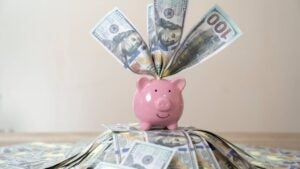4 money moves to make while rates are high

When the Federal Reserve hikes rates, banks tend to follow suit by raising rates on their deposit accounts as well as loans. Currently, we’re in a high-rate environment, thanks to the Fed having gradually raised its key federal funds rate to its highest target range in 22 years. What’s more, policymakers see one more rate hike happening this year to continue fighting inflation, according to projections.
As a consumer, the current high-rate environment is a great time to work on increasing your savings and paying down debt. Here are four smart money moves you can make now while rates are high.
1. Build up your emergency fund
An emergency fund is a household necessity, because it provides a cushion to cover unplanned expenses such as a job loss or an unexpected home repair. The best spot for money you might need in a pinch is a liquid savings account. Right now, high-yield savings accounts are earning rates that outpace inflation, which makes it a great time to beef up your savings.
Open a high-yield savings account: The best high-yield savings accounts are currently earning annual percentage yields (APYs) of 5.25 percent. Because rates vary considerably among banks — and many large brick-and-mortar banks pay rates that are rock-bottom — it’s important to shop around for the right savings account for you. Other factors to consider include whether there’s a minimum balance requirement or a monthly service fee.
Online-only banks are often where you’ll find savings accounts with high APYs. These banks, eager to bring in more customers to help grow their deposit accounts, offer higher rates compared with traditional banks. What’s more, online banks don’t have to pay for overhead costs associated with maintaining branches, so they’re able to pass along the savings to customers in the form of higher rates.
How much interest a high-yield savings account can earn: If you deposit $10,000 in a high-yield savings account that’s earning a 5.25 percent APY, you’ll earn $525 in interest in one year. (For simplicity’s sake, the rate in our example remains unchanged for the year, although in reality some banks will change their savings account rates at least once over a year’s time.)
How much to save in your emergency fund: Experts recommend having three to six months’ worth of living expenses in an emergency fund. Having this cushion provides money you’d need for living expenses if you were hit with a sudden job loss. This money can also come in handy for unplanned expenses such as a car repair or a doctor’s bill.
2. Save toward financial goals
In addition to building up your emergency fund, it can pay to take advantage of high rates by saving money toward other financial goals. Nearly three-quarters of consumers (71 percent) reported being somewhat or very likely to set financial goals in 2023, a Bankrate survey found.
Setting aside money in a high-yield savings account earns you some interest while you save toward future goals. Examples of such savings goals include:
- Making a down payment on a house
- Buying a car
- Taking a vacation
- Making home renovations
- Buying holiday gifts
Consider multiple savings accounts: If you’re saving toward multiple goals at once, one way to keep funds separate is to open a different savings account for each goal. This strategy helps you keep track of each savings goal’s progress and how close you are to meeting each goal.
Find a savings account with buckets: Another strategy is to open a savings account that allows you to devote portions of your money to different categories or buckets. Ally Bank provides such a savings account, which lets you create up to 30 buckets for different goals. NBKC Bank also offers the ability to set savings goals in its Everything Account.
Ultimately, building up your savings during a high-rate environment helps you reach your goals faster while also maximizing the effect of compound interest.
3. Consider a CD
Rates on certificates of deposits (CDs) are currently at their highest in years, so opening a CD now means you’ll continue to earn its high yield even if rates start to fall. This is because a CD earns a guaranteed APY, in exchange for locking in your money for a set amount of time.
How much interest a CD can earn: For example, if you open a one-year CD today that earns a 5.5 percent APY, you’ll have earned around $550 when the CD matures. Bankrate’s CD calculator can help you figure out how much interest you’ll earn when you input the amount you’ll deposit, the APY and the term length.
Where to find a top-paying CD: Like savings accounts, the highest-earning CDs are often found at online-only banks. These banks also commonly require a low minimum balance, or none at all.
It’s important to shop around for a CD that earns a competitive yield, as rates vary considerably among banks. For instance, while top-paying banks are offering APYs upwards of 5.5 percent for one-year CDs, various big brick-and-mortar banks are paying a meager rate of just 0.01 percent.
What a CD is good for: A CD can be a great place to park some money that you’ll need for a future goal such as purchasing a house or a new vehicle, or taking your dream vacation. You’ll reap the benefits of a high rate of return, and locking in your money means you won’t be tempted to use it for other purposes such as impulse spending.
What a CD is not good for: It’s important not to lock in funds you might need in the near future for living expenses or emergencies. Taking money out of a CD before its term expires usually results in a hefty early withdrawal penalty. As such, money you may need at a moment’s notice is better off in a liquid savings account.
4. Pay down credit card debt
Like deposit account rates, lending rates charged by banks also tend to go up when the Fed raises interest rates. More often than not, the annual percentage rate (APR) of a credit card will be variable, meaning it changes according to the prime rate.
With credit card interest rates rising, it’s getting increasingly expensive to carry a balance. You can lessen the harmful effects of a rising APR by focusing more on paying down your credit card debt, with the goal of eventually eliminating it. Ways to increase the amount you send to your credit card each month can include:
- Cutting unnecessary spending from your budget
- Increasing your income by working extra hours or starting a side hustle
Balance transfer credit cards: Another strategy is to transfer the balance from one or more credit cards to a card with a lower APR, which could ultimately help save you hundreds or even thousands of dollars’ worth of interest. Finding a balance transfer card with a 0 percent introductory APR means you’ll be able to spend time paying down the balance without incurring any new interest on it.
The introductory APR typically lasts between 12 and 21 months, after which the higher APR will take effect that’s listed in your credit card agreement. Note that to qualify for a 0 percent balance transfer credit card, you’ll likely need good-to-excellent credit. You’ll also likely need to pay a balance transfer fee up front.
If you’re carrying a large amount of credit card debt, the stress you’re feeling may be even greater due to recent APR increases. Consider working with a certified credit counselor to come up with a plan for eliminating your debt.
Bottom line
A high-rate environment is a great time to increase your savings and pay down debt. If you’re looking to come up with more money to devote to these things, consider finding ways to cut expenses from your budget. Easy targets to save can include eating out less or cutting back on online subscriptions you’re paying for but not using. Also consider finding a side hustle, which can help you earn extra money by doing something you enjoy.
Ultimately, making certain money moves during the current high-rate environment can help you build up your nest egg, pay down debt, and increase your peace of mind.






